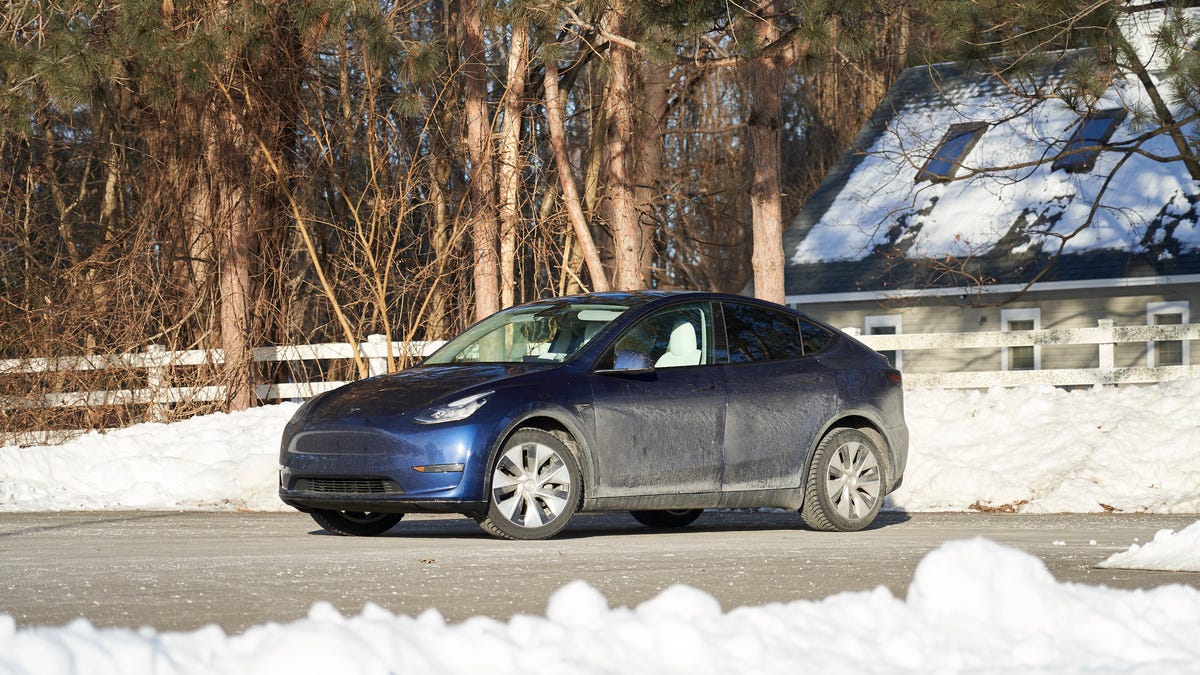2021 Tesla Model Y long-term update: Charging through the snow
It's widely believed that EVs are terrible in the winter. How does the Tesla Model Y fare? I headed up to the Canadian border to find out. Twice.

Filthy? Yes, but this time of year, that's to be expected.
The old adage "if you're cold, they're cold" applies not only to pets and memes but to EVs, too, and early examples really struggled. When we did a long-term test of a Nissan Leaf, my first drive in that thing was in cold conditions where it struggled to deliver even half its estimated range.
In the few years since then, we've come a long way. Today's EVs fare much better than you might expect. The Porsche Taycan recently impressed me by beating its EPA range on a road trip to Vermont. But with our long-term Tesla Model Y, I wanted to be a little more scientific.
If you haven't been following along, we took the plunge and bought our own Tesla Model Y at the end of last summer. Well, we leased it, anyway -- a 24-month journey into the full Tesla ownership experience. I'll be shepherding the car through the winter, then it'll head westward to live with other members of the team.
Since the last update, winter has truly fallen here in Upstate New York where I live. The cold came late but it came on strong, bringing along snow and ice and everything nice. Before winter properly set in, I took a run up to the northern part of the state, just shy of the Canadian border, to get a feel for the Model Y's range as the temperatures were starting to drop.
After that, I swapped on a set of snow tires. Even though our Model Y offers all-wheel drive thanks to its dual-motor configuration, anyone who's spent any amount of time driving in inclement conditions will tell you that AWD doesn't help you when stopping, and it isn't necessarily a big help when turning, either. To help that you need more grip and that only comes from a good set of snow tires.
To get us through, Nokian was kind enough to send us a set of its recently released Hakkapeliitta 10 EV tires. Despite being impossible to spell correctly on the first try, the Hakka series has gotten me through many a harsh winter, even those where I've managed to get in a little ice racing. But as great as those tires are for winter grip, they tend to be quite loud thanks both to the metal studs and the chunky tread profile. Additionally, while their soft compound delivers excellent grip, I typically saw a 10% to 15% reduction in fuel economy when running them on my Subarus.
This new EV flavor of Hakka promises two big improvements. First, like many EV-specific tires, they contain an inner layer of foam to quell road noise. Additionally, they're made of a different compound to reduce rolling resistance. Could the Hakka 10 EV offer all the grip with none of the compromises? After getting them mounted, initial impressions are good. At low speeds, mostly cruising through parking lots, you still get that typical studded tire noise, which sounds a bit like someone mounted a popcorn popper to the underside of your car.
A look at the inside of a "regular" Nokian Hakka 10 (top) vs. the new Hakka 10 EV (bottom). You can see the layer of foam in the EV flavor, which cuts noise.
However, once you get up to 20 mph or so, that sound disappears. At speed the tires are barely louder than the Tesla's stock Continental all-seasons. In fact, with the softer sidewalls, the Model Y's crude ride quality is actually improved. Most importantly, the Model Y was nervous in slippery conditions on its stock tires. On the Hakkas? It's a real pleasure to drive in the snow, just playful enough to be fun but the safety systems kicking in early and often to ensure you keep going where you want.
And what about the range? Well, after fitting the winter tires, I headed on the same, 164-mile road trip up north. Unfortunately, a cold front swept through before my second trip, which means it isn't quite the direct comparison I'd hoped. The first trip, on all-season tires and through 37-degree Fahrenheit air, the car consumed 50 kilowatt-hours for an average consumption of 304 watt-hours per mile. The second trip, chillier at 21 degrees and on snow tires, the car consumed 54 kWh at 331 Wh/mi.
The Model Y is rated for 270 Wh/mi when EPA-tested at room temperature (roughly 70 degrees), so that initial drop down to 37 degrees for the first test deducted about 10% from that. The second test, going down another 16 degrees and swapping to snow tires, cost roughly another 10%. That means temperature and snow tires resulted in a net reduction of just over 20%.
Studs are overkill for most, but when the weather turns icy they're awfully nice to have.
That, to me, is a solid performance. Do the math and you get a theoretical maximum range of 260 miles on 20-degree driving days with snow tires. It also means the Hakka 10 EV tires impacted range by significantly less than 10%.
I'll try to do another test in the spring to see if I can't get a more specific range impact figure on the tires themselves, but with that much range at our disposal I'll surely be putting plenty of miles on the Model Y over the winter and, if we get lucky, I might even get it out on some ice to play. Stay tuned.

